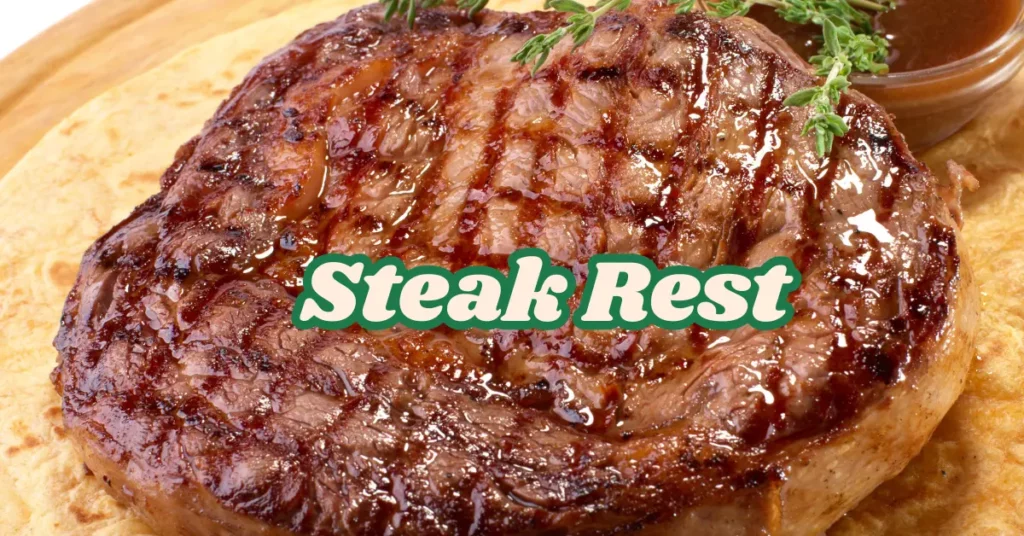This post may contain affiliate links. If you use these links to buy something we may earn a small commission. Thanks.
Cooking a perfect steak is a culinary achievement. You’ve selected a prime cut, seasoned it beautifully, and cooked it to just the right doneness. But before you grab your knife and fork, there’s one final step that makes all the difference letting your steak rest. This seemingly simple step can take your steak from good to unforgettable.
In this guide, we’ll dive deep into why resting your steak is essential, how long you should do it, and the science behind it. If you’ve ever sliced into a freshly cooked steak and watched all the juices run out, this article is for you.
What Does It Mean to Rest a Steak?
When chefs talk about “resting” a steak, they’re referring to the short period after cooking when the steak is taken off the heat but not immediately cut into or served. During this time, the meat relaxes, and something magical happens inside juices that were driven to the center during cooking redistribute evenly throughout the steak.
While it might be tempting to dig in right away, a rested steak rewards your patience with enhanced moisture, flavor, and tenderness.

Why Resting Steak Is Important
1. Juice Redistribution
When a steak cooks, heat causes its juices to migrate toward the center. If you slice it immediately after cooking, those juices spill out and end up on your cutting board instead of in your mouth. Resting gives the juices time to move back toward the edges, ensuring every bite is succulent.
2. Improved Texture
Resting allows the muscle fibers to relax and reabsorb moisture, making the meat softer and easier to chew. A rushed slice often leads to a drier and chewier experience.
3. Enhanced Flavor
Steak that retains its juices also retains its flavor. A properly rested steak doesn’t just feel juicier—it tastes richer and more concentrated.
How Long Should You Let Steak Rest?
So how long should you wait before cutting into your beautifully cooked steak? Here’s a breakdown:
General Guideline: 5 to 10 Minutes
A safe, universal recommendation is to let your steak rest for at least 5 minutes. But depending on the cut, size, and thickness, the ideal resting time may vary.
Rest Time by Thickness
- 1-inch thick steak: Rest for about 5 minutes
- 1.5-inch thick steak: Rest for about 7–8 minutes
- 2-inch thick steak or more: Rest for 10–15 minutes
Rule of Thumb: 1 Minute Per 100 Grams
Some chefs prefer to rest steak for 1 minute per 100 grams (3.5 ounces). While not an exact science, it’s a helpful estimate if you’re cooking unfamiliar cuts.
Large Cuts Need Longer Rest
If you’re cooking ribeye, T-bone, porterhouse, or tomahawk steaks, give them extra time to rest—10–15 minutes is ideal. These cuts are denser and thicker, requiring more time for juices to redistribute properly.
Resting Time Based on Cooking Method
The cooking method also influences how long a steak should rest:
Grilled Steak
Grilled steaks, especially over high heat, require at least 5–10 minutes to cool slightly and redistribute juices evenly.
Pan-Seared Steak
Pan-seared steaks may retain a bit more moisture due to the even heat. Still, a 5–7 minute rest is recommended.
Oven-Cooked or Broiled Steak
Oven or broiler heat penetrates more evenly than direct flame, but resting is still crucial—go for 7–10 minutes, depending on the cut.
Sous Vide Steak
Since sous vide cooks steak evenly and at lower temperatures, the resting time can be shorter. A 2–3 minute rest after searing is often enough unless you used a high-heat sear for a crust.
Should You Tent the Steak with Foil While Resting?
You might’ve seen people covering their steak loosely with foil during the resting period. This technique is called “tenting”, and it has its pros and cons.
Pros
- Helps retain heat longer
- Protects steak from ambient drafts or a cold environment
Cons
- Traps steam, which can soften the crust or cause overcooking
- Can lead to excess moisture buildup, diluting flavor or causing sogginess
The Best Practice
If you choose to tent your steak, do it loosely don’t wrap it tightly like a baked potato. Leave enough room for steam to escape while still keeping the steak warm.
Does Steak Keep Cooking While Resting?
Yes, it does—and this phenomenon is called carryover cooking. Once the steak comes off the heat, its internal temperature can continue to rise by 5°F or more, depending on the size and cut.
This is especially important for precision cooks. If you’re aiming for a medium-rare doneness of 130°F, consider removing the steak from heat at 125°F, knowing that it will finish cooking during the rest.
How to Tell When a Steak is Properly Rested
You don’t always need a stopwatch. Here are a few signs that your steak has rested enough:
- Juices have settled: When you gently press the steak, you don’t see a flood of juice.
- Surface looks relaxed: The meat appears less taut and more evenly colored.
- Even internal color: When you slice it, you see uniform pink or red tones rather than a gray band with a red center.
Optionally, you can also check the internal temperature. If it’s stabilized and not rising anymore, your steak is fully rested.
Common Mistakes When Resting Steak
❌ Cutting Too Soon
This is the most common mistake and completely defeats the purpose of resting. Even a few extra minutes can make a big difference.
❌ Resting Too Long
Letting steak sit for too long can cause it to go cold and lose its texture. Try not to exceed 15 minutes for most cuts.
❌ Wrapping Steak Tightly
Tightly covering the steak traps steam, which can ruin the crust and cause sogginess.
❌ Using a Cold Surface
Avoid placing the steak on a cold plate or board. It can cause the steak to cool too fast and disrupt the resting process. Use a warm plate or wooden board instead.
Expert Tips for the Best Rested Steak
- Rest steak on a warm plate or cutting board to maintain temperature.
- Use a rack or slotted tray to prevent the steak from sitting in its own juices.
- Time your side dishes to be ready while the steak is resting it keeps the whole meal hot and perfectly timed.
- If you’re cooking multiple steaks, stagger them so you always have one resting while the next is cooking.
Frequently Asked Questions
Can you rest steak too long?
Yes. Beyond 15–20 minutes, steak can cool down too much and lose its appeal. The sweet spot is usually 5–10 minutes.
Do all meats need to rest?
Most meats, especially red meats like beef, lamb, and pork, benefit from resting. Even chicken and turkey should rest before carving.
Is resting necessary for medium-rare or rare steaks?
Absolutely. Even rare steaks need time to settle and reabsorb juices after cooking.
Should you rest steak if serving right off the grill?
Yes. Even if you’re serving immediately, a brief rest enhances flavor and texture.
Conclusion
The next time you cook steak, don’t skip the rest. That short wait 5 to 10 minutes isn’t just a pause in cooking. It’s an essential part of creating a restaurant-quality steak at home.
Letting your steak rest ensures that every bite is juicy, flavorful, and tender, and your effort in selecting and cooking that perfect cut will truly shine. Whether you’re cooking a quick sirloin or an impressive tomahawk, remember: patience makes the perfect steak.
